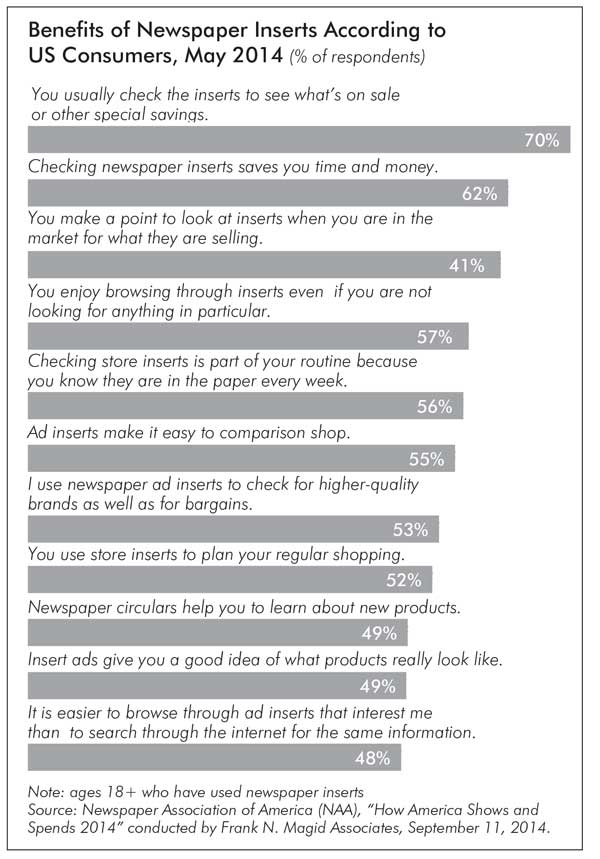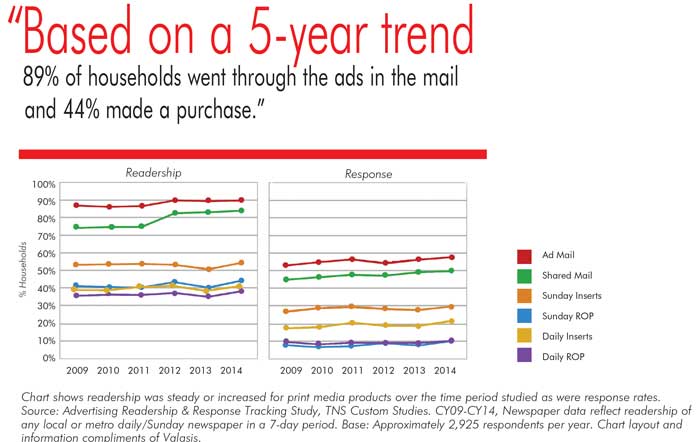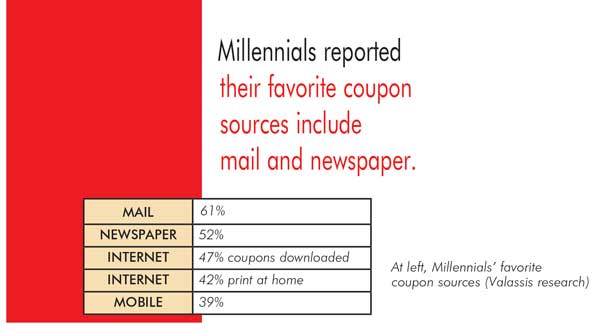Why is it... everyone thinks the print insert is dead... when it certainly is NOT!
I bet you’re wondering why I’m writing about this, when virtually all of my Retail Rants on my website www.social4retail.com are about why and how you must focus on your on-line marketing strategies in this digital age. That’s because three fundamentals, Frequency, Consistency and Reach still exist across all platforms, no matter what your marketing strategy is.
It started with an email from “Think with Google”, which I subscribe to, everyone should. The information that was sent was how consumers reacted to the Super Bowl Ads. The article was titled: “How the Big Game Played Out on the Second Screen,” that can be found at (http://bit.ly/1R9YC7T). Here is a quick summary of the research:
Commercials during the Super Bowl don’t just make us laugh or cry—they also make us search. This year, there were more than 7.5 million searches for the brands advertised during the game. This searching represents a seven times higher response rate compared to a typical TV ad, even after normalizing for audience size. Second-screen searching—whether it’s to re-engage with the ad, to learn more about the product, or to purchase—is a powerful indication of brand interest. For brands, that means a presence on the big screen isn’t complete without a strategy for the small screen, too.

OK, I know it’s the Super Bowl, but after reviewing the article, I became curious about how traditional marketing and digital interact when it comes to engaging consumers on their pathway to purchase. This is what I found...and it will enlighten you:
According to a study by e-Marketer (
http://bit.ly/1Qo9aNC):
U.S. adult consumers who had used newspaper inserts, or FSI’s (Free Standing Inserts) cited deal-related benefits. Fully 70% said they checked the inserts to find out about sales and savings, while 62% said the fliers saved them time and money. 56% had clipped coupons from a newspaper insert in the 30 days prior to polling.
Interestingly, a majority of respondents enjoyed looking through newspaper inserts, with 57% browsing even when not in the market for an item. 56% reported doing so simply because it was a part of their routine. See more at
http://tinyurl.com/gt6xtx5
The proof that inserts do work, doesn’t end there. Consider this research:
Two-thirds of newspaper readers either always or regularly look at inserts, according to Coda Ventures’ Triad research, a Nashville-based research firm specializing in newspaper research. Coda Ventures recently reported that fewer than nine percent of newspaper readers state that they “seldom or never” look at inserts.

And, most important to advertisers, newspaper inserts drive action. Nine out of ten newspaper readers report that they take one or more of a broad range of specific actions after reading or looking at inserts.
Other recent research by Research and Analysis of Media (RAM), an international media research company, confirms the crucial role newspaper inserts play in consumer marketing. Data shows that nearly nine in 10 media consumers use newspaper inserts. This is much higher than the usage of direct mailers.
I could literally bore you to death with statistics and research. Instead, I’ve pulled out the most relevant facts for this quick read.
When I contacted Valassis for supplemental information, the two charts on this and the following page really stood out:
Before proceeding with this discussion, please understand that I am not suggesting that you use newspapers as your primary delivery vehicle. Subscription rates to newspapers are dying a slow death, except the Sunday editions where people look for your inserted promotions.
In some of the larger markets, subscriptions may still be relevant; however, in most markets, use delivery vehicles like the Valassis Red Plum, delivered in the mailbox, if it’s not delivered in your local paper. AND don’t rely on a “print-only strategy”; you have to integrate your promotional print program with digital too, because according to Valassis:
- 46% of consumers’ interaction with media is spent with print and mobile.
- 60% of adult purchase decisions are influenced by both print and digital.
A survey conducted by Valassis (http://bit.ly/1Ksenb6) found that within 30 days of viewing a newspaper insert, 30% of people went online to get more information. This is just one of many reasons you MUST have a robust website with tons of content for consumers to shop.
Additionally, the Wall Street Journal substantiated the news that newspaper inserts drove more retail shoppers than digital ads, and are, without a doubt, the most powerful drive-to-retail media available to marketers.
So, how do you get started to take advantage of a fully integrated selling strategy with this information?
FIVE STEPS
1. Only work with a company that knows this industry, unless you do it all in-house. Work with a company that specializes in the furniture category with the creative design, print and distribution for your print program. If you need a recommendation for a company that has dropped over a billion print inserts for thousands of retailers, and has a contract with Valassis, critical so that you get the best rate, visit http://www.social4retail.com/print-inserts-still-work. There you will also find more on this topic with downloadable research, videos and more.
Be sure to have a call to action, a coupon offer or something that you can track your promotion’s effectiveness, AND be sure that this call to action is done digitally with integration on mobile and on your website. Using geography-based targeting is key to increase your ROI, delivering relevant, localized messages to high-opportunity consumers via desktop, mobile or tablet.
2. Create a budget. Typical advertising budgets retailers should be looking at are between 5%-10% of sales. Be sure you take into consideration the key home furnishing shopping dates in the fall, spring, summer and winter so you get maximum engagement.
The average cost just for the print portion runs between $.08-$.10/each as a delivered price, which should include everything: design, print, and distribution for the printed insert. But there are a variety of options to consider: Red Plum wrap, ROP ads, solo mail options and more. This is why you need to deal with a specialist that knows all of the available options and can recommend the best platform based off your store’s profile and budget.
3. Know your target audience. Have a target market profile created by Valassis for your retail location(s). This will highlight the areas you should focus on, based on your store’s information. This will include zip codes, income levels, market indices - propensity to buy, and more, so you can develop a plan.
I suggest you test a number of offers on the different demographic groups you’ve identified in your area. If you’re targeting Boomers, you may want to focus on mattresses, recliners and other products your CRM/POS software shows are most likely to engage that demographic. The same with younger Millennials, maybe beds/bedrooms... that’s the first item people buy when they move out of Mom & Dad’s, out of apartment living, etc.
4. Track Everything. Don’t assume anything. Ask consumers how they heard of you, what brought them to the store, website visits before and after the promotion drops, what they bought vs. what was promoted and more.
You need to gauge effectiveness, so start with the basics and work with your CRM/POS programs to fine-tune this strategy.
5. Analyze, fine-tune and REPEAT at least monthly. Bi-monthly if you’re in a competitive market.
Knowledge is power and information creates knowledge. Fine-tune what you know and then put it to good use by repeating this process over and over. REMEMBER, “Water dripping on a stone leaves a mark,” and also remember the three pillars of marketing: Frequency, Consistency and Reach.

Conclusion
So why is it that everyone thinks printed inserts are dead when in fact, they have been shown to:
- Have demonstrated dynamic and lasting effectiveness.
- Have the ability to target specific days of the week – such as mid-week (via shared mail) and/or Sundays (via the newspaper).
- Reach a large, influential and “targeted” audience.
- Make the overall shopping process easier for consumers.
For additional information on this topic with downloadable research, videos and more, visit;
http://www.
social4retail.com/print-inserts-still-work
About Bill Napier: Bill Napier is Managing Partner of Napier Marketing Group. He has been the CMO of several small, medium and large companies throughout his career, most notably Ashley Furniture Industries Inc. from 2000-2005. His passion is to help retail brands and brick & mortar retailers grow their respective businesses by integrating traditional marketing with the web/social media. For more information visit www.social4retail.com.
Furniture World is the oldest, continuously published trade publication in the United States. It is published for the benefit of furniture retail executives. Print circulation of 20,000 is directed primarily to furniture retailers in the US and Canada. In 1970, the magazine established and endowed the Bernice Bienenstock Furniture Library (www.furniturelibrary.com) in High Point, NC, now a public foundation containing more than 5,000 books on furniture and design dating from 1620. For more information contact editor@furninfo.com.